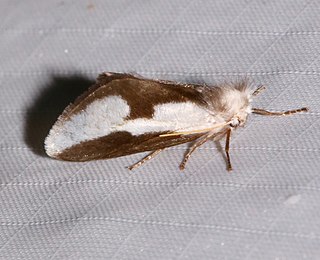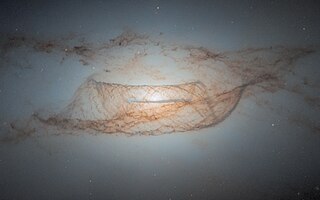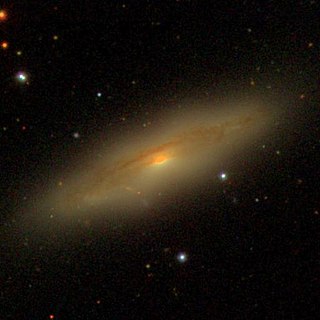
Messier 61 is an intermediate barred spiral galaxy in the Virgo Cluster of galaxies. It was first discovered by Barnaba Oriani on May 5, 1779, six days before Charles Messier discovered the same galaxy. Messier had observed it on the same night as Oriani but had mistaken it for a comet. Its distance has been estimated to be 45.61 million light years from the Milky Way Galaxy. It is a member of the M61 Group of galaxies, which is a member of the Virgo II Groups, a series of galaxies and galaxy clusters strung out from the southern edge of the Virgo Supercluster.

The flannel moths or crinkled flannel moths are a family of insects.

The Shapley Supercluster or Shapley Concentration is the largest concentration of galaxies in our nearby universe that forms a gravitationally interacting unit, thereby pulling itself together instead of expanding with the universe. It appears as a striking overdensity in the distribution of galaxies in the constellation of Centaurus. It is 650 million light-years away (z=0.046).

NGC 5247 is a face-on unbarred spiral galaxy located some 60 million light years away in the constellation Virgo. It is a member of the Virgo II Groups, a series of galaxies and galaxy clusters strung out from the southern edge of the Virgo Supercluster. This is a grand design spiral galaxy that displays no indications of distortion caused by interaction with other galaxies. It has two spiral arms that bifurcate after wrapping halfway around the nucleus. The disk is estimated to be 4.9 ± 2.0 kly (1.5 ± 0.6 kpc) in thickness and it is inclined by roughly 28° to the line of sight.

Norape is a genus of moths in the family Megalopygidae. The genus was erected by Francis Walker in 1855.

NGC 4527 is a spiral galaxy in the constellation Virgo. It was discovered by German-British astronomer William Herschel on 23 February 1784.
Norape truncata is a moth of the family Megalopygidae. It was described by Walter Hopp in 1927. It is found in Venezuela, Peru and Colombia.
Norape plumosa is a moth of the Megalopygidae family. It was described by Arthur Gardiner Butler in 1877. It is found in Costa Rica, Panama and the Amazon region.
Norape argyrorrhoea is a moth of the Megalopygidae family. It was described by Jacob Hübner in 1825. It is found in Argentina, Trinidad, Brazil, Guyana, Venezuela, Paraguay, Panama, Costa Rica and Mexico.
Norape beggoides is a moth of the Megalopygidae family. It was described by Harrison Gray Dyar Jr. in 1910. It is found in Brazil.
Norape laticosta is a moth of the Megalopygidae family. It was described by Harrison Gray Dyar Jr. in 1910. It is found in Mexico (Guerrero).

Norape tener, the mesquite stinger moth, is a species of moth in the family Megalopygidae. It was described by Herbert Druce in 1897. It is found in Mexico and the south-western US.
Norape xantholopha is a moth of the Megalopygidae family. It was described by Harrison Gray Dyar Jr. in 1914. It is found in Panama, Guatemala, Colombia and Peru.

NGC 4753 is a lenticular galaxy located about 60 million light-years away in the constellation of Virgo. NGC 4753 was discovered by astronomer William Herschel on February 22, 1784. It is notable for having distinct dust lanes that surround its nucleus. It is a member of the NGC 4753 Group of galaxies, which is a member of the Virgo II Groups, a series of galaxies and galaxy clusters strung out from the southern edge of the Virgo Supercluster.

NGC 4586 is a spiral galaxy located about 50 million light-years away in the constellation Virgo. The galaxy was discovered by astronomer William Herschel on February 2, 1786. Although listed in the Virgo Cluster Catalog, NGC 4586 is considered to be a member of the Virgo II Groups which form a southern extension of the Virgo cluster. NGC 4586 is currently in the process of infalling into the Virgo Cluster and is predicted to enter the cluster in about 500 million years.

NGC 4546 is a lenticular field galaxy located in the direction of the constellation Virgo, with a total population of globular clusters estimated at 390. It is a member of the Virgo II Groups, a series of galaxies and galaxy clusters strung out from the southern edge of the Virgo Supercluster.

NGC 4701 is an unbarred spiral galaxy located in the constellation Virgo. Its velocity with respect to the cosmic microwave background is 1054 ± 24 km/s, which corresponds to a Hubble distance of 50.7 ± 3.8 Mly (15.54 ± 1.15 Mpc). However, 10 non-redshift measurements give a greater distance of 72.31 ± 6.14 Mly (22.170 ± 1.883 Mpc).It was discovered by the German-British astronomer William Herschel on 30 April 1786 using a 47.5 cm diameter mirror type telescope. It is a member of the Virgo II Groups, a series of galaxies and galaxy clusters strung out from the southern edge of the Virgo Supercluster.

NGC 4179 is a lenticular galaxy located in the constellation Virgo. It was discovered by William Herschel on January 14, 1784. It is a member of the NGC 4179 Group of galaxies, which is a member of the Virgo II Groups, a series of galaxies and galaxy clusters strung out from the southern edge of the Virgo Supercluster.

NGC 4324 is a lenticular galaxy located about 85 million light-years away in the constellation Virgo. It was discovered by astronomer Heinrich d'Arrest on March 4, 1862. NGC 4324 has a stellar mass of 5.62 × 1010M☉, and a baryonic mass of 5.88 × 1010M☉. The galaxy's total mass is around 5.25 × 1011M☉. NGC 4324 is notable for having a ring of star formation surrounding its nucleus. It was considered a member of the Virgo II Groups until 1999, when its distance was recalculated and it was placed in the Virgo W Group.

NGC 4995 is a "moderately bright and large galaxy" in the constellation Virgo. It is a member of the NGC 4995 Group of galaxies, which is a member of the Virgo II Groups, a series of galaxies and galaxy clusters strung out from the southern edge of the Virgo Supercluster.














